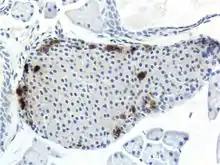Pancreatic polypeptide
Pancreatic polypeptide (PP) is a polypeptide secreted by PP cells in the endocrine pancreas predominantly in the head of the pancreas. It consists of 36 amino acids and has molecular weight about 4200 Da.[1] The function of PP is to self-regulate pancreatic secretion activities (endocrine and exocrine). It also has effects on hepatic glycogen levels and gastrointestinal secretions.
| Pancreatic polypeptide | |||||||
|---|---|---|---|---|---|---|---|
 | |||||||
| Identifiers | |||||||
| Symbol | PPY | ||||||
| NCBI gene | 5539 | ||||||
| HGNC | 9327 | ||||||
| OMIM | 167780 | ||||||
| RefSeq | NM_002722 | ||||||
| UniProt | P01298 | ||||||
| Other data | |||||||
| Locus | Chr. 17 p11.1-qter | ||||||
| |||||||

Its secretion in humans is increased after a protein meal, fasting, exercise, and acute hypoglycemia, and is decreased by somatostatin and intravenous glucose.
Plasma PP has been shown to be reduced in conditions associated with increased food intake and elevated in anorexia nervosa. In addition, peripheral administration of PP has been shown to decrease food intake in rodents.[2] Pancreatic polypeptide (PP) is a peptide hormone found in the islets of Langerhans and between the acinar cells that inhibits pancreatic secretion of fluid, bicarbonate, and enzymes.It also stimulates the gastric juice secretion, but inhibits the gastric secretion induced by pentagastrine. It is the antagonist of cholecystokinin and inhibits the pancreatic secretion which is stimulated by cholecystokinin. On fasting, PP seric concentration is 80 pg/ml; after the meal, it rises up from 8 to 10 times more; glucose and fats also induce PP's level increase, but on parenteral introduction of those substances, the level of hormones doesn't change. The administration of atropine, the vagotomy, blocks the PP's after-meal secretion. The excitation of the vagus nerve, the administration of gastrin, secretin or cholecystokinin induce PP secretion.
The augmentation of PP secretion has been observed in hormonal-active pancreatic tumors (insulin, glucagon), in Verner-Morrison syndrome, and in gastrinomas.
The PPY gene encodes an unusually short protein precursor that is cleaved to produce PP, as well as pancreatic icosapeptide and a 5- to 7- amino-acid oligopeptide.[3]
References
- Lonovics J, Devitt P, Watson LC, Rayford PL, Thompson JC (Oct 1981). "Pancreatic polypeptide". Arch. Surg. 116 (10): 1256–64. doi:10.1001/archsurg.1981.01380220010002. PMID 7025798.
- Batterham, RL; Le Roux, CW; Cohen, MA; Park, AJ; Ellis, SM; Patterson, M; Frost, GS; Ghatei, MA; Bloom, SR (Aug 2003). "Pancreatic polypeptide reduces appetite and food intake in humans". The Journal of Clinical Endocrinology and Metabolism. 88 (8): 3989–92. doi:10.1210/jc.2003-030630. PMID 12915697.
- Boel, E.; Schwartz, T. W.; Norris, K. E.; Fiil, N. P. (April 1984). "A cDNA encoding a small common precursor for human pancreatic polypeptide and pancreatic icosapeptide". EMBO Journal. 3 (4): 909–912. doi:10.1002/j.1460-2075.1984.tb01904.x. PMC 557446. PMID 6373251.
External links
- Nosek, Thomas M. "Section 6/6ch2/s6ch2_25". Essentials of Human Physiology. Archived from the original on 2016-03-24.
- Pancreatic+polypeptide at the US National Library of Medicine Medical Subject Headings (MeSH)
- BBC Hope over 'obesity-busting gum' 15 January 2007
- http://library.usmf.md/downloads/ebooks/Endocrinology_Anestiadi_en_2003/Lecture_11_p.(167-200).pdf%5B%5D